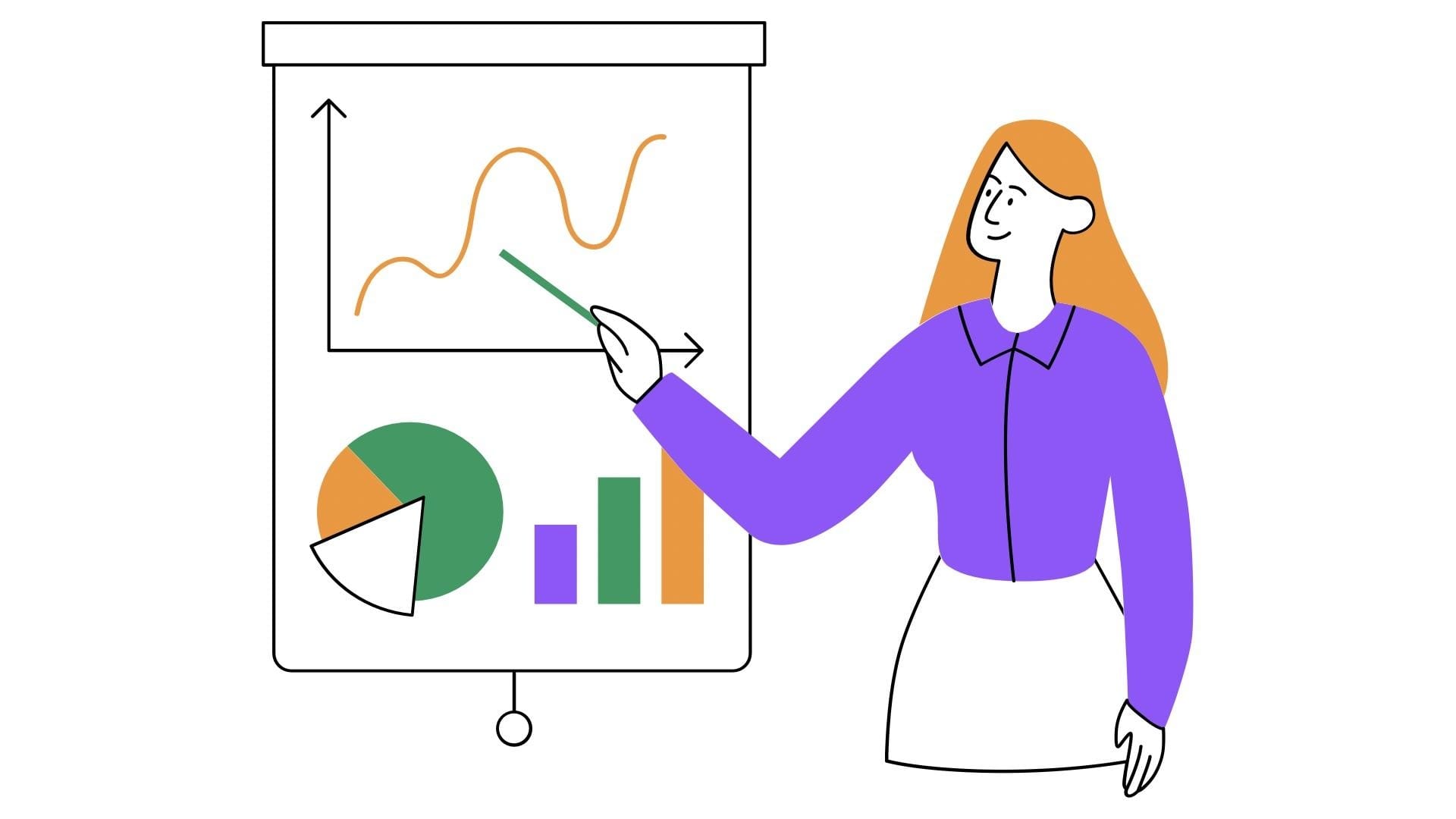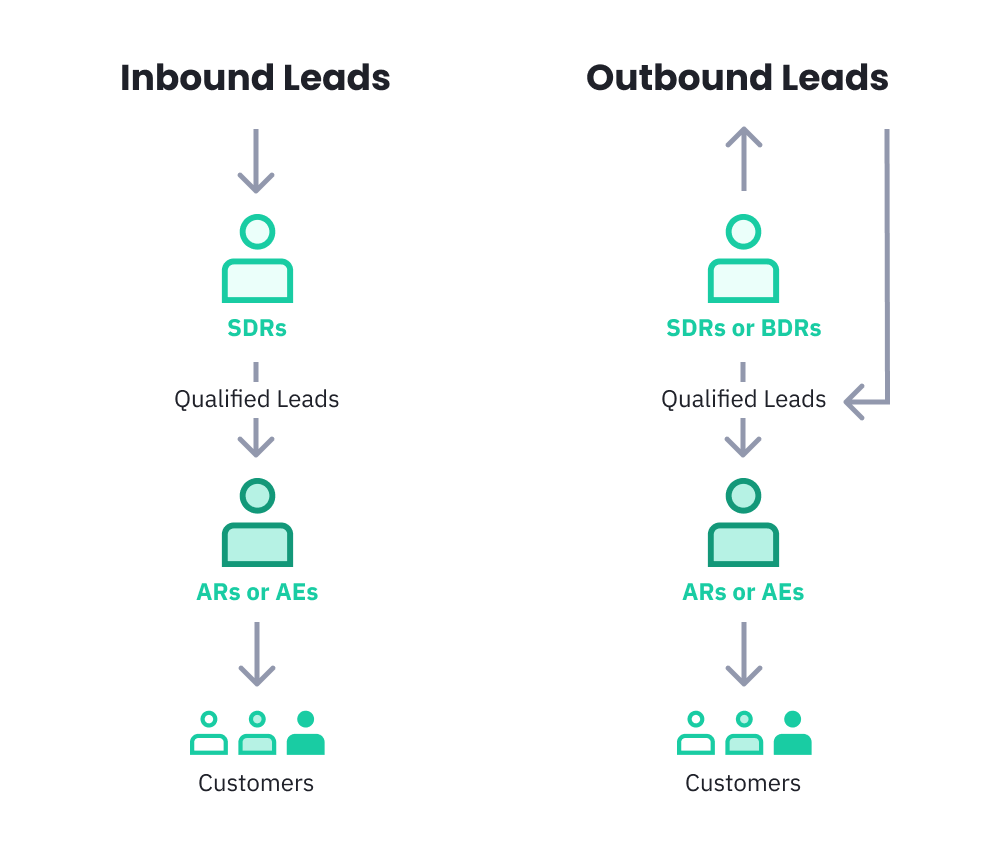What is the Role of SDR in Sales and Marketing
Understanding the role of SDRs is crucial for optimizing sales and marketing integration.

For founders, CEOs, and sales managers focused on scaling the business and driving revenue, Sales Development Representatives (SDRs) play a pivotal role in streamlining sales and boosting growth.
In small to medium businesses (SMBs) and enterprises alike, SDRs and business development representatives are crucial for managing lead generation, qualification, and nurturing relationships until they’re ready for a smooth handover to sales teams.
Let’s dig into the article that explores how SDRs bridge marketing and sales, the tools they use, and the metrics that demonstrate their value.
What Is SDR Marketing and SDR Sales?
Sales Development Representative (SDR) marketing refers to the strategies and activities in supporting marketing efforts. The SDR role can sometimes be misunderstood, with debates over whether it is a marketing or a sales function, or how is sdr marketing different from sales.
In reality, SDRs are a blend of both, performing tasks that are integral to the success of each department, and their collaboration with sales and marketing teams is crucial for providing valuable feedback on lead quality and campaign performance.
Who is a Sales Development Representative?
A Sales Development Representative is responsible for engaging with potential customers, assessing their needs, and qualifying leads to determine if they’re a good fit for the company’s offerings.
SDRs initiate contact, typically via cold outreach or responses to marketing inquiries, guiding leads toward a deeper exploration of products or services. They lay the groundwork for a smooth handover to the sales team, who then works to convert these qualified leads into paying customers.
What Skills Does an SDR Need?
The SDR role requires a unique skill set that blends communication, research, and organization. Here are some key competencies:
- Communication Skills: SDRs engage prospects, making communication a crucial skill. Effective SDRs can convey value propositions, answer questions, and build rapport.
- Active Listening: Understanding each lead’s needs is essential. Active listening enables SDRs to identify potential pain points and respond accordingly.
- Time Management and Organization: SDRs manage multiple leads, follow-ups, and administrative tasks. Strong organizational skills ensure that leads are effectively nurtured through each stage.
- Technical Proficiency: SDRs leverage CRM software, lead qualification tools and automation platforms to track and manage interactions. Proficiency in these tools is essential for streamlining workflows.
- Resilience and Persistence: SDRs face frequent rejection in their outreach efforts, so they must maintain a resilient attitude and stay motivated to find the right prospects.
- Understanding the Customer's Journey: It is crucial for SDRs to understand the customer's journey and the differentiation of roles in sales and marketing. This includes qualifying inbound marketing leads without over qualifying them to avoid inefficiencies and ensure a well-structured go-to-market (GTM) strategy.
Now let’s look into the top responsibilities and roles that SDR has to handle.
The Top 3 Roles of an SDR in Sales and Marketing
Is SDR marketing just about cold outreach? SDRs wear many hats, but three core responsibilities drive their value within sales and marketing organizations. Each role contributes uniquely to the sales pipeline and company growth.
- Strategies for Effective Prospecting
For any business leader aiming to grow revenue, is SDR marketing effective? Prospecting is critical. Effective prospecting fills the pipeline with leads and ensures that these leads align with the company’s ideal customer profile. Here’s how SDRs approach this responsibility:
Identify Ideal Customer Profiles (ICP):
SDRs collaborate with marketing and sales teams to define the Ideal Customer Profile (ICP). This profile includes details such as industry, company size, role of the decision-maker, and specific needs that align with the product’s strengths. By targeting this profile, SDRs focus on prospects with the highest conversion potential.
Conduct Outreach:
Outreach efforts rely on a multi-channel approach, utilizing emails, calls, and social media to engage potential customers. Recent data shows that multi-channel outreach can improve response rates by as much as 70%, as it meets prospects where they are most active.
SDRs leverage these channels to connect with prospects at multiple touchpoints, increasing their chances of engagement.
Personalized Messaging:
By tailoring messaging to each prospect’s specific needs, SDRs engage leads on a deeper level. For leaders looking to maximize ROI, personalized SDR outreach translates to higher-quality interactions and, ultimately, better conversion rates.
Source: Link
Tools like Alisha (AI SDR) can automatically write personalized emails with an open rate of 50%.
- Lead Qualification and Nurturing
Lead qualification and nurturing are essential in determining if a lead is worth pursuing further. This process saves time and resources by ensuring only qualified leads advance to the sales team.
Qualify Leads:
SDRs evaluate each lead using frameworks like Budget, Authority, Need, and Timing (BANT). This strategic filtering process improves your team’s productivity by keeping them focused on prospects who are more likely to convert, saving time and resources.
Nurture Leads:
For prospects who aren’t ready to buy, SDRs start nurturing relationships by sharing relevant information, involving regular follow-ups, informative content, and consistent check-ins. Is SDR marketing worth it? Nurtured leads have been shown to make 47% larger purchases than non-nurtured leads, underscoring the importance of consistent engagement.
Source: Link
Focus on Quality:
High-quality leads generate better results. Rather than reaching out to large volumes of cold contacts, SDRs focus on leads that fit your business profile and have shown genuine interest, ensuring more productive engagement and stronger pipeline health.
- Communication and Collaboration Techniques
SDRs act as a bridge between marketing and sales, aligning communication and collaboration to improve lead quality and optimize sales processes.
Educate Prospects:
By educating prospects about how the product or service can solve specific pain points, SDRs lay a solid foundation for the sales team. This education process requires SDRs to stay informed about product updates and industry trends to deliver the most relevant information to prospects.
Collaborate with Account Executives (AEs) and Business Development Reps (BDRs):
The SDR role is the starting point in sales—essentially, the frontline team screening leads. They connect with each prospect, weeding out those who aren’t a fit. Qualified leads then move up to account reps (ARs) or account executives (AEs) who focus on closing deals.
In bigger teams, SDRs may work with business development reps (BDRs) who handle outbound leads, while SDRs focus on inbound ones. Transitioning from an SDR role to the marketing team is a valid career path, leveraging the skills gained as an SDR and providing an alternative route within the business.

Source:Link
ARs and AEs rely on the SDRs to keep a steady stream of qualified leads. Without their filtering, the sales process drags as closers talk to unqualified leads, risking lost opportunities and longer sales cycles.
SDR and BDR sales marketing, this teamwork ensures that AEs have the context to tailor their approach, increasing the likelihood of closing deals.
Utilize CRM and Communication Tools:
With tools like CRM systems, SDRs keep detailed records of every lead interaction, ensuring consistency and accuracy across the sales process. CRM systems streamline communication, create accountability, and contribute to seamless handoffs between departments for founders and CEOs looking to build a high-performing team.
Now let’s dive into the tools that SDRs can utilize to boost their work performance:
Tools and Platforms for SDRs
A variety of tools support SDRs in executing their roles effectively. For those wondering is SDR marketing the future, a poll by PeerSignal on LinkedIn found that 53% think the future is AE + AI + SDR in marketing, highlighting the role of tech in driving SDR success.
A variety of tools support SDRs in executing their roles effectively. Here are some of the most commonly used types:
Lead Qualification Tools
Lead qualification tools help SDRs score leads, generate sales qualified leads, prioritize high-potential clients, and streamline the qualification process.
- Apollo: Apollo offers an extensive database of prospects enriched with contact details and behavioral insights that SDRs can use to identify and qualify leads. Apollo’s advanced filters help SDRs find leads that match the company’s Ideal Customer Profile (ICP), boosting the efficiency of prospecting efforts.
Source:Link
- Resquared (Re2.ai): Resquared is a powerful sales automation tool tailored for reaching local businesses. It offers a comprehensive local business database and advanced sales features. It simplifies lead generation by connecting sales teams with the right local prospects while automating outreach to maximize efficiency.
Source:Link
- SurfaceLabs (withsurface.com): SurfaceLabs provides AI-driven, no-code forms designed to elevate lead capture, qualification, and nurturing. With seamless CRM integration, it automates workflows, delivering enriched data and qualified leads directly to sales teams.
Source:Link
CRM Systems
Customer Relationship Management (CRM) platforms are essential for tracking leads, managing communication, and collaborating with team members.
- HubSpot CRM: HubSpot CRM is known for its intuitive interface and rich feature set. It offers comprehensive lead management, automated call and email tracking, and customizable reporting, making it ideal for SMBs looking for powerful yet user-friendly CRM capabilities.

Source: Link
- Salesforce CRM: A market leader in CRM, Salesforce provides advanced customization and a powerful suite of features for larger teams. It is designed for businesses that require a flexible, scalable CRM solution with integration across multiple departments.
Source: Link
- Zoho CRM: Zoho CRM is another excellent choice, particularly for smaller teams that need a comprehensive yet affordable solution. With Zoho, SDRs can manage contacts, automate outreach, and monitor lead progress.

Source: Link
AI and Automation Tools
Automation tools enhance SDR productivity by handling repetitive tasks like email follow-ups and outreach scheduling, freeing SDRs to focus on more strategic activities.
- Alisha AI SDR: Alisha AI SDR is a virtual assistant explicitly designed for SDRs. It handles tasks like lead follow-ups and data entry. This tool uses AI to learn from past interactions, enabling it to make smarter recommendations for future outreach. With its powerful ThorV2 engine it can generate more accurately than ChatGPT’s model.
Source: Link
Supercharge Your SDRs—Discover How Floworks Can Drive Consistent Growth.
- Roger Tool (thanksroger.com): Roger is a smart e-contract app designed to streamline contract creation, signing, and management all in one place. It lets you securely send, track, and sign documents online, making contract workflows faster and hassle-free. With ThanksRoger, you can skip the paperwork and manage all your contracts digitally, anywhere, anytime.

Source: Link
- Outreach.io: Known for its robust sales engagement features, Outreach.io automates entire communication sequences, helping SDRs maintain consistent contact with leads. It also provides engagement analytics, helping SDRs fine-tune their approach over time.
Source: Link
Key Performance Metrics for SDRs in Marketing
Evaluating SDR performance in marketing requires tracking specific metrics that reveal their impact on lead generation, sales, and, ultimately, revenue.
Outreach and Conversion Rates
For SDR marketing, outreach quality is essential. Key metrics include:
- Response Rate: Measures how many prospects respond to initial contact. A higher response indicates well-aligned messaging.
- Conversion Rate: Reflects how many responses convert into qualified leads. Effective SDR product marketing strategies yield higher conversions, showing a direct link to sales goals.
Sales Pipeline Contribution
Sales development reps play a critical role in filling the sales funnel, making their contribution key to understanding SDR marketing success:
- Qualified Leads Generated: The number of prospects who meet the criteria for further engagement. High-quality leads indicate strong SDR targeting skills.
- Pipeline Value: Ties SDR efforts in marketing directly to potential revenue, offering insight into how SDRs fuel sales potential.
- Time to First Contact: Measures how quickly SDRs reach new leads. Fast response times generally lead to higher engagement and conversion.
Impact on Revenue Growth
While not closing deals, SDRs heavily influence revenue growth. Key metrics include:
- Deals Influenced: Tracks the number of closed deals that began as SDR marketing-generated leads, demonstrating the long-term impact of SDR outreach.
- SDR-to-Closed-Won Ratio: Shows the percentage of SDR-generated leads that convert into closed deals, linking their work to actual revenue outcomes.
Career Development and Growth for SDRs
As a Sales Development Representative (SDR), career development and growth are essential to advancing in the sales industry. With the right training, support, and experience, SDRs can move up the career ladder and take on more challenging roles.
Career Paths and Promotions
SDRs can progress to various roles within the sales organization, including:
- Account Executive (AE): Responsible for closing deals and managing existing relationships.
- Business Development Representative (BDR): Focuses on outbound prospecting and moving qualified leads through the pipeline.
- Sales Manager: Oversees a team of SDRs and AEs, providing guidance and support to ensure sales targets are met.
- Sales Director: Responsible for developing and executing sales strategies to drive revenue growth.
To get promoted, SDRs should focus on:
- Consistently meeting or exceeding sales targets
- Developing strong relationships with customers and colleagues
- Demonstrating a deep understanding of the sales process and industry
- Taking on additional responsibilities and contributing to the growth of the sales team
Is SDR a Good Career Choice?
Being an SDR can be a rewarding and challenging career choice for those who enjoy sales, communication, and problem-solving. As an SDR, you will have the opportunity to:
- Develop strong relationships with customers and colleagues
- Learn about different industries and businesses
- Improve your communication and negotiation skills
- Contribute to the growth and success of the sales team
However, being an SDR can also be demanding, with high targets and rejection rates. To succeed, SDRs must be resilient, motivated, and willing to continuously learn and improve.
How to Succeed as an SDR in Marketing
Beyond metrics, successful SDRs master skills and strategies that enhance their effectiveness in marketing and sales roles. Here’s how to thrive as an SDR.
Continuous Learning
Sales and SDR marketing trends evolve fast. Top SDRs stay sharp by:
- Seeking Feedback: Regular feedback helps SDRs refine their techniques.
- Investing in Training: Learning new tools and strategies in SDR marketing keeps SDRs ahead of the curve.
Check out: How AI is Revolutionizing Sales Enablement: Real-World Use Cases and What's Next!
Adaptability
Flexibility is key for an SDR to balance sales and marketing. To improve:
- Experiment with Outreach: Trying different messaging and approaches helps SDRs find the best methods to connect with potential customers.
- Mastering New Tools: Staying updated on CRM and automation tools is crucial for SDR product marketing success.
Networking
Building strong connections is essential:
- Collaborating with Teams: Working closely with marketing and sales teams helps SDRs understand their role in the pipeline.
- Engaging Prospects: Building relationships with potential clients, even those not ready to buy, can lead to future opportunities.
By focusing on these metrics and skills, you can excel in SDR marketing, fueling your company’s pipeline and bridging the gap between marketing and revenue.
Conclusion
SDRs are vital for businesses seeking to streamline lead generation and sales processes. By using tools for lead qualification, CRM, automation, and communication, SDRs can save time, automate tasks, and prioritize high-potential leads, addressing key pain points around efficiency and scalability.
This optimized approach improves engagement and drives consistent results, making SDRs essential to any effective SDR marketing strategy. But as demands grow, it's tough to keep up without burning out or missing key chances for growth.
This is where Floworks comes in to help founders, CEOs, and sales managers empower their SDR teams by automating routine tasks, enhancing lead qualification, and enhancing revenue.
With Alisha, your team can focus on strategic growth, maximizing productivity without additional headcount, and driving consistent results for your business.
Transform your sales process today with Floworks. Contact us to see how we can elevate your SDR strategy!
FAQs
What are the three key criteria for being successful as an SDR in your opinion?
Success as an SDR requires resilience to handle frequent rejections, strong communication skills to engage and qualify prospects, and exceptional time management to effectively juggle multiple leads. Persistence and adaptability in different sales scenarios can also give SDRs an edge.
What is the responsibility of SDR?
SDRs Sales Development Representatives play a crucial role in generating and qualifying leads for the sales team by identifying potential clients, initiating conversations, and nurturing interest. They focus on early-stage relationship-building to create a pipeline of prospects ready for deeper sales discussions.
How to describe SDR on the resume?
On a resume, highlight your lead generation and prospecting skills, emphasizing achievements like "increased qualified leads by X%" or "consistently achieved X% of monthly quota." Mention experience with CRM tools and metrics showing your impact on pipeline growth.
What is the role of SDR?
The SDR role focuses on top-of-the-funnel activities, such as finding and engaging new leads, qualifying them based on their potential fit, and passing them to sales reps. It's a key entry-level sales position that lays the foundation for successful sales conversions.


